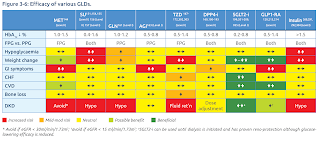Oral Glucose Lowering Drugs
Introduction
Oral agents used in type 2 diabetes mellitus are
- Biguanides, e.g. metformin
- Sulfonylureas, e.g. glibenclamide (glyburide), gliclazide
- Meglitinides, e.g. repaglinide
- α-Glucosidase inhibitors, e.g. acarbose
- Thiazolidinediones, e.g. pioglitazone
- DPP-4 inhibitors, e.g. sitagliptin, vildagliptin, saxagliptin
- SGLT-2 inhibitors, e.g. dapagliflozin, empagliflozin
Metformin (Biguanide)
Metformin remains the initial drug of choice for type 2 diabetes, unless it is contraindicated or adverse effects preclude its use.
- Metformin exerts its effect mainly by decreasing gluconeogenesis and by increasing peripheral utilisation of glucose.
- It does not cause weight gain or hypoglycaemia when given alone.
The most common adverse effects of metformin are gastrointestinal disturbances, including anorexia, nausea, abdominal discomfort and diarrhoea. These gastrointestinal side effects are usually transient and can be minimised by
- Administering the drug with or after food.
- Starting with a low dose and increasing it slowly.
- Using an extended-release formulation.
- Limiting dose to 2 g/day. If doses >2g/day are needed, administer in 3 divided doses.
Long-term use of metformin may interfere with absorption of vitamin B12.
Lactic acidosis is a rare but potentially life-threatening complication of metformin.
- Patients at most risk are those with renal insufficiency and those who are unable to metabolise lactate.
- Hence, metformin should be avoided in patients with eGFR <30 ml/min/1.73 m2, severe liver impairment, hypoxic pulmonary disorder disease or shock.
Sulfonylureas (SU)
The sulfonylureas act mainly by stimulating insulin secretion by increasing pancreatic β-cell sensitivity to glucose.
- For many agents, the maximum effect is seen if the dose is taken half an hour before a meal, rather than with or after food.
The most common adverse effects of sulfonylureas are weight gain and hypoglycaemia.
- Weigh gain in the range of 1.31-3.32 kg is common since sulfonylureas stimulate appetite.
- Hypoglycaemia is more likely to occur with long-acting sulfonylureas such as glibenclamide (and perhaps glimepiride).
- Long-acting sulfonylureas are best avoided in the elderly and in patients with even mild renal impairment because of the risk of hypoglycaemia.
- Some medications can produce severe hypoglycaemia when with a sulfonylurea, such as NSAIDs, warfarin, alcohol, monoamine oxidase inhibitors, some antibacterial drugs (including sulfonamides, trimethoprim and chloramphenicol) and some imidazole antifungal drugs.
The 30 mg gliclazide modified-release tablet is equivalent to the 80 mg immediate-release tablet.
Meglitinides (GLNs)
Like sulfonylurea, the meglitinides (or glinides) stimulate first-phase insulin secretion, but they lack the sulfonylurea moiety. The release of insulin only occurs in the presence of glucose.
- Meglitinides should be taken immediately before main meals, although the time can vary up to 30 minutes before a meal.
- Hence, these drugs can be used flexibly around mealtimes and adjusted to fit around individual eating habits.
Meglitinides may cause a range of side effects, most commonly hypoglycaemia, weight gain, visual disturbances, abdominal pain, diarrhoea, constipation, nausea and vomiting.
- More rarely, hypersensitivity reactions and elevation of liver enzymes can occur.
α-Glucosidase Inhibitors (AGIs)
Acarbose is a medication that delays the digestion and absorption of starch and sucrose, thus reducing the postprandial increase in blood glucose.
- Acarbose tablets should be chewed with first mouthful of food, or swallowed whole with a little liquid immediately before food.
The most common adverse effects of acarbose are flatulence, loose stools or diarrhoea and abdominal pain and bloating.
Thiazolidinediones (TZD)
The thiazolidine (or glitazones) are peroxisome proliferator-activated receptor-γ (PPAR-γ) agonists and act primarily by increasing insulin sensitivity in muscle, adipose tissue and liver.
The thiazolidine is associated with weight gain and several long-term risks, hence are now far less frequently used.
- Thiazolidinediones are contraindicated in patients with congestive cardiac failure and liver failure.
- There is also increased risk of bone fracture, and it should be used with caution in post-menopausal women.
- The use of pioglitazone may increase the risk of bladder cancer.
Dipeptidyl Peptidase-4 (DPP-4) Inhibitors
DPP-4 inhibitors prolong incretin activity and lower glucagon release.
- This in turn decreases blood glucose and increases insulin secretion.
DDP4-inhibitors are predominantly renally excreted, but a degree of hepatic metabolism is also involved.
- Dosage adjustment is required in renal impairment for alogliptin, sitagliptin, saxagliptin and vildagliptin.
All DPP-4 inhibitors have been linked to gastro-intestinal side effects and upper respiratory tract infection.
- DPP-4 inhibitors do not cause hypoglycaemia, but they can increase the risk of hypoglycaemia when combined with other medications that can also cause hypoglycaemia.
- Saxagliptin is not recommended in patients with pre-existing heart failure as it has been shown to be associated with increased risk of hospital admission for heart failure.
- Vildagliptin has been associated with rare reports of liver dysfunction.
DPP-4 inhibitors have a low potential for drug interactions.
- However, both sitagliptin and saxagliptin are metabolised by cytochrome P450 3A4/5 (and CYP2C8 for sitagliptin), and therefore have the potential to interact with potent inducers or inhibitors of these enzymes.


Comments
Post a Comment